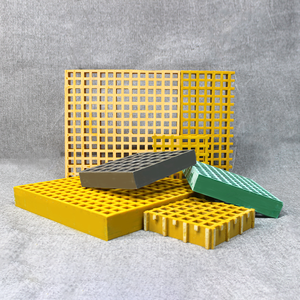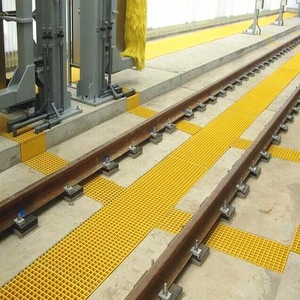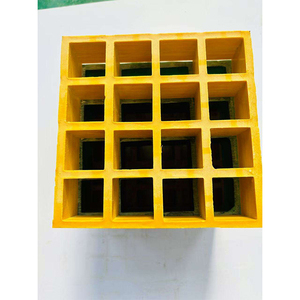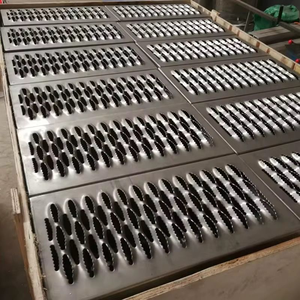
All categories
Featured selections
Trade Assurance
Buyer Central
Help Center
Get the app
Become a supplier

(9642 products available)



















































Grating mesh flooring, also known as grating floor mesh, is an essential flooring solution. It is often used in many industries because of its strength, durable build and unmatched anti-slip properties.
Grating floor mesh is manufactured to all global standards, including ASTM, BS, and DIN and is available in various types. Some of these types are:
Steel grating floor mesh
Steel grating floor meshes are designed for heavy-duty applications. They are manufactured to support high loads within industrial or commercial spaces. The high tensile strength of steel, makes this flooring suitable for any construction project and ideal for warehouses, factories, and other industrial facilities.
Steel floor mesh for reinforced concrete
This type of floor mesh is widely used in foundation applications within the construction industry. Reinforced concrete floor meshes are manufactured from steel wire. They add tensile strength to concrete structures such as walls, floors and beams. The meshes within the concrete reinforce the structure to allow it support heavy loads without cracking or breaking.
Aluminum grating floor mesh
Aluminum grating floor mesh is lightweight, corrosion resistant and as strong as steel grating. It is ideal for use in areas prone to moisture such as marine applications or food processing plants. The non-corrosive property of aluminum, makes it a practical choice for outdoor decking and walkways as it will not rust or degrade when exposed to the elements.
Press locked floor mesh
Press locked floor mesh utilizes a unique locking mechanism. This system is designed to provide a smooth, flat surface that is capable of bearing heavy loads. The industrial locking system, tightly secures the cross bars and bearing bars together, creating a cohesive flooring solution ideal for platforms, catwalks and other elevated surfaces that require stability and safety.
Mesh floor panel with 3mm wire
This type of panel is constructed of metal wires with a 3mm diameter for the ultimate durability and stability. The closely spaced wires provide a solid walking surface while allowing for drainage and ventilation. The 3mm metal wire diameter makes this panel ideal for use in industrial and commercial settings, where heavy foot traffic or equipment loads are expected.
Mesh floor panel with 6mm wire
This type of panel, depending on the distribution of its wires, can offer a more open or solid surface compared to the 3mm panel. Because of the thicker wire diameter, the 6mm panel is better suited for applications that require greater strength. These applications include supporting heavy equipment or larger loads in warehouses and factories.
Key features that buyers should consider when buying grating floor mesh include:
Heavy duty construction
Grating floor mesh is designed to withstand heavy loads within industrial and commercial applications. The critical features that provide this kind of strength include the materials used to make them and the unique designs. Some meshes are made with steel or aluminum. This gives them the ability to support machinery, foot traffic and even vehicular loads. Most of these meshes also have a slip resistant surface that provides safety in areas where moisture or debris can create a hazard.
High wear resistance
Wear resistance is among the most important features of grating-floor mesh, especially for those used in high-traffic environments. These meshes are manufactured using materials that do not degrade with regular use. They also have a robust surface that protects them from abrasion. In addition, many grating meshes feature anti-corrosive treatments or coatings. These features ensure that the mesh can perform reliably in demanding conditions and for multiple years.
Drainage system
Every grating floor mesh comes with an innovative drainage system design. The open design enables water, chemicals, and debris to drain away quickly and efficiently. This feature, therefore, minimizes the risk of pooling, which can cause safety hazards like slipping or structural damage over time. The drainage capability also makes these meshes suitable for environments where wet conditions are common. These conditions include outdoor areas, factories and processing plants.
Anti-slip surface
The anti-slip surface property of the grating floor mesh makes it ideal for application in spaces with high moisture content. These surfaces are designed with textured patterns or bar distributions that provide excellent traction for both bare and safety-shod feet. This reduces the risk of slipping in any environment, whether it be an industrial area or a commercial kitchen. The anti-slip surface contributes to overall safety by providing reliable footing, even in wet or oily conditions.
Mesh open area
The open area of the grating floor mesh significantly influences its load-bearing capability and application suitability. Different types of grating floor mesh have varying open areas. These closely affect the degree of airflow, light penetration, and liquid or debris passage. Buyers have to select grate types based on operational requirements. This consideration ascertains optimal performance in their unique applications, whether for walkways, platforms, or machinery bases.
Key considerations that buyers should co nsider to make the right choice include:
Application
Floor mesh grating type should be determined by the intended use. For industrial settings with heavy machinery or foot traffic, steel or aluminum grating is ideal because of their strength. For applications requiring more lightweight but still robust flooring, close wire spaced types can be considered. For reinforced concrete structures, a steel mesh that is suitable for reinforced concrete is recommended. Also, meshes with 3 or 6 mm diameter wires are to be used for concrete reinforcement.
Loading capacity and mesh open area
The loading capacity and mesh open area play a key role in determining the performance of the floor mesh grating. The loading capacity should always match or exceed the expected load within any application. A greater mesh open area, typically between 40-50%, promotes better drainage and ventilation. However, the open area should not compromise the structural integrity of the grating. Therefore, buyers should select a mesh that balances both criteria for optimal performance.
Safety and anti-corrosive properties
There are some floor meshes that are specifically designed for hazardous environments. These come with anti-slip surfaces that mitigate the risk of slip and fall accidents. In addition, anti-corrosive treatments or coatings, such as galvanization, enhance the durability of the mesh in wet or chemically aggressive environments. These features ensure long-term safety and reliability within spaces including outdoor walkways and industrial platforms.
Maintenance and ease of installation
Floor meshes for grating with minimal upkeep are preferred in many commercial settings since they do not have time to waste. Grating meshes made with non-corrosive materials such as aluminum require relatively less frequent maintenance, compared to their steel counterparts, which O have to undergo regular cleaning to prevent rust formation. In addition, buyers should also consider the ease of installation. Some mesh types come with pre-fabricated mounting systems that can be quickly and easily installed, and this can greatly reduce the time and labor costs involved in the setup process.
Installation of the grating floor mesh depends on the type of mesh. However, there are some general steps that apply to most types. They include:
Preparing the subfloor
Clear out debris and remove any old flooring in the subfloor preparation stage. This will make way for the grating mesh. Then, inspect the subfloor for any signs of damage and repair these areas as necessary. The subfloor should be clean, level and dry before the grating floor mesh is laid down. It is also advisable to take measurements to ensure the correct amount of grating mesh is used.
Laying the mesh
Buyers should unroll the grating floor mesh and lay it out. It should be positioned over the prepared subfloor. Some meshes are laid directly, like welded wire meshes, while others have to be secured with framing or supports. The buyer should ensure the mesh is flat and aligned properly with any adjoining surfaces. In this way, any excess mesh can be trimmed to fit using cutting tools designed for the specific mesh material.
Securing the mesh
The securing of the mesh will depend on the kind of flooring being utilized. Take, for instance, in the case of attaching the mesh to concrete floors, the grating can be secured using adhesive, anchors or a thick concrete overlay. On the other hand, the mesh can be secured to wooden subfloors using screws or fasteners that are driven into place. Both methods employed must ensure the grating is stable and cannot shift or warp over time.
Finishing touches
Completing the installation of grating floor mesh will require addressing any edges or joins, including the installation of trim pieces and edge bands to allow for a neat finish. Buyers should then do a final inspection to ensure the mesh is securely in place and properly aligned. Any areas that need adjustment should be dealt within the finishing touches. Some installations may require additional sealing or coating, and these can enhance the durability and slip-resistant properties of the grating.
Some of the benefits of floor mesh grating include:
Ideal for reinforced concrete
The grating floor mesh makes it an ideal choice for reinforced concrete applications because it is manufactured to add tensile strength to concrete structures. This meshes even tension and compression forces within the concrete. This integration provides unparalleled structural integrity within beams, slabs and walls. As a result, it minimizes crack formation and structural failure. It therefore reinforces the concrete’s natural properties while offering unparalleled tensile support.
Prevents rust and corrosion
The floor mesh grating is made from either aluminum or galvanized steel, both of which are anti-corrosive. As such, it is suitable for use in outdoor and industrial applications that are susceptible to rain, humidity or chemical exposure. The meshing’s corrosion resistance ensures that it remains strengthened, safe and dependable, even after long exposure to hostile environmental conditions.
Increases safety
The open design of the grating floor mesh allows for effective drainage and prevents the accumulation of water and debris. This feature helps to reduce the risk of slipping, therefore providing a safer walking and working surface within hazardous environments. Additionally, the sturdy construction of the mesh provides reliable support for heavy equipment and foot traffic. This further enhances safety by minimizing the risk of collapses or unstable flooring.
Low maintenance costs
Grating floor mesh, especially when made from galvanized steel or aluminum, is relatively low-maintenance due to its high resistance to rust and corrosion. The durable materials and open design also make it easy to clean and resistant to wear. This feature of the meshing makes it ideal for use in different demanding environments where regular maintenance of the flooring can be time-consuming and costly.
The kind of maintenance required will depend on the material of the meshing. In other words, the type of maintenance required for galvanized steel grating will be different from aluminum grating. The user should always refer to the manufacturer’s instructions on how best to maintain the mesh to ensure it lasts long and performs optimally.
Yes, grating floor meshes can be cut to size. In fact, most manufacturers encourage buyers to customize their floor mesh to fit the unique specifications of their ideal applications. Moreover, most grating types can be cut using standard power tools. However, it is recommended that the cutting be done with a grinder or a hacksaw blade designed specifically for the mesh material. This ensures that there is no further damage to the mesh and that it retains its desirable properties even after customization.
Properly storing the grating floor mesh before installation is critical for the quick installation as well as for the optimal performance of the mesh. To store the mesh, the user should first cover the mesh to protect it from moisture, dust and debris. They should also elevate the mesh off the ground to prevent it from being wet or damaged. Furthermore, the storage area should be cool, well ventilated and free from direct sunlight. All these considerations will ensure that the mesh does not warp and its corrosion resistant properties do not diminish in the case of steel mesh.
No, it is not necessary as professional installation is not a prerequisite for Floor grating meshes. Many of them have simple DIY installation procedures. These procedures include mounting and securing the grating by bolting or screwing them into place. Although, some complex installations like those involving concrete overlays may require professional help.
Industries that normally experience high traffic and hazardous conditions are the ones commonly using the floor mesh grating. Some of these industries include manufacturing plants, chemical facilities, and food processing units, to mention but a few. They also use meshes with open areas that allow for drainage and air circulation, which is ideal for these industries. Outdoor walkways, platforms, and loading docks are some of the other areas that frequently utilize grating floor mesh.